新目标英语九年级全册教案
新目标九年级英语教案(4篇)
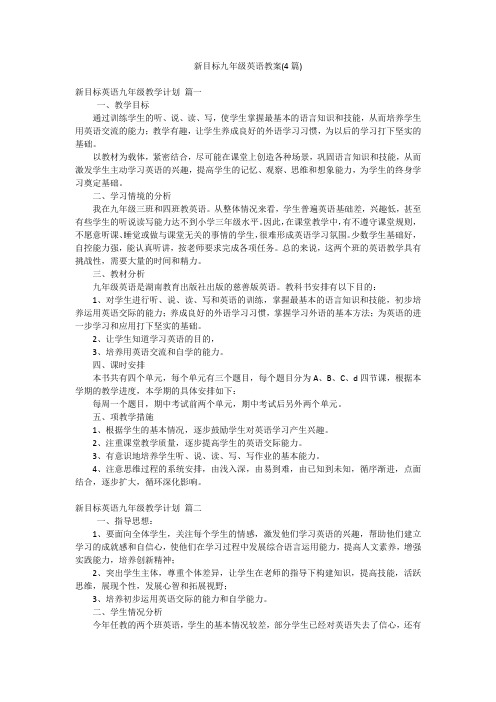
新目标九年级英语教案(4篇)新目标英语九年级教学计划篇一一、教学目标通过训练学生的听、说、读、写,使学生掌握最基本的语言知识和技能,从而培养学生用英语交流的能力;教学有趣,让学生养成良好的外语学习习惯,为以后的学习打下坚实的基础。
以教材为载体,紧密结合,尽可能在课堂上创造各种场景,巩固语言知识和技能,从而激发学生主动学习英语的兴趣,提高学生的记忆、观察、思维和想象能力,为学生的终身学习奠定基础。
二、学习情境的分析我在九年级三班和四班教英语。
从整体情况来看,学生普遍英语基础差,兴趣低,甚至有些学生的听说读写能力达不到小学三年级水平。
因此,在课堂教学中,有不遵守课堂规则,不愿意听课、睡觉或做与课堂无关的事情的学生,很难形成英语学习氛围。
少数学生基础好,自控能力强,能认真听讲,按老师要求完成各项任务。
总的来说,这两个班的英语教学具有挑战性,需要大量的时间和精力。
三、教材分析九年级英语是湖南教育出版社出版的慈善版英语。
教科书安排有以下目的:1、对学生进行听、说、读、写和英语的训练,掌握最基本的语言知识和技能,初步培养运用英语交际的能力;养成良好的外语学习习惯,掌握学习外语的基本方法;为英语的进一步学习和应用打下坚实的基础。
2、让学生知道学习英语的目的,3、培养用英语交流和自学的能力。
四、课时安排本书共有四个单元,每个单元有三个题目,每个题目分为A、B、C、d四节课,根据本学期的教学进度,本学期的具体安排如下:每周一个题目,期中考试前两个单元,期中考试后另外两个单元。
五、项教学措施1、根据学生的基本情况,逐步鼓励学生对英语学习产生兴趣。
2、注重课堂教学质量,逐步提高学生的英语交际能力。
3、有意识地培养学生听、说、读、写、写作业的基本能力。
4、注意思维过程的系统安排,由浅入深,由易到难,由已知到未知,循序渐进,点面结合,逐步扩大,循环深化影响。
新目标英语九年级教学计划篇二一、指导思想:1、要面向全体学生,关注每个学生的情感,激发他们学习英语的兴趣,帮助他们建立学习的成就感和自信心,使他们在学习过程中发展综合语言运用能力,提高人文素养,增强实践能力,培养创新精神;2、突出学生主体,尊重个体差异,让学生在老师的指导下构建知识,提高技能,活跃思维,展现个性,发展心智和拓展视野;3、培养初步运用英语交际的能力和自学能力。
新目标(Go for it)版初中英语九年级(全一册)全册教案
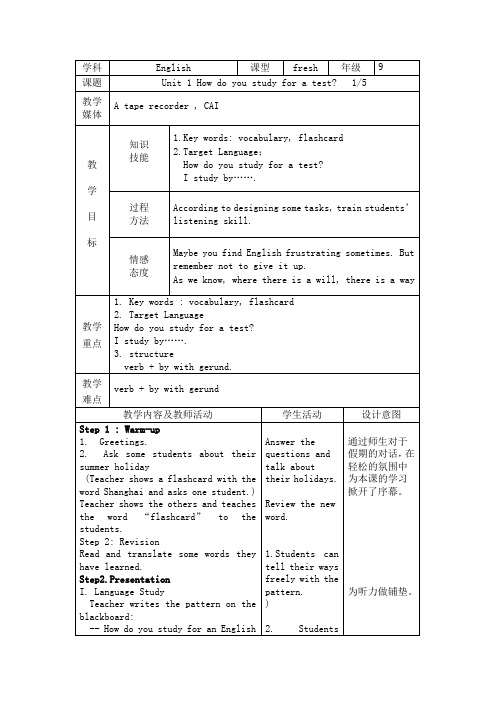
1.Check the answers, after checking, read the ways to the students and ask students to put up their hands to show which things they checked. Count the numbers.
情感
态度
If there is an English club in your school, join it to improve your English
教学重点
Key words : Key Vocabulary&Target Language
Structure:verb + by with gerund.
Make similar conversation by oneself.
Work in pairs to present their conversations.
Work in groups.
Interview.
通过师生对于假期的对话,在轻松的氛围中为本课的学习掀开了序幕。
为听力做铺垫。
检测学生的听力水平。
by working with Friendsby making flashcardsby reading the textbook
by making vocabulary listsby listening to cassettes
2. Target language
A: How do you study for a test?
Teacher shows the others and teaches the word“flashcard”tothe students.
人教新目标版九年级英语全册全一册教案
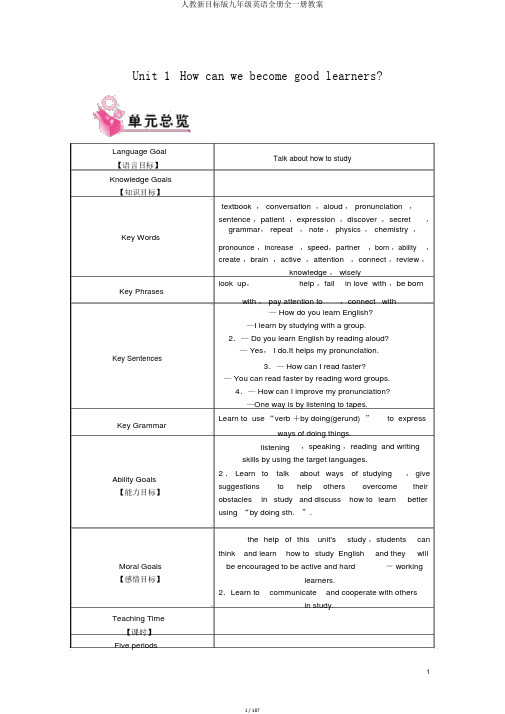
Unit 1 How can we become good learners?Language GoalTalk about how to study【语言目标】Knowledge Goals【知识目标】textbook , conversation ,aloud , pronunciation ,sentence ,patient ,expression ,discover ,secret ,grammar, repeat , note , physics , chemistry ,Key Words,speed,partner ,born ,ability ,pronounce ,increasecreate ,brain ,active ,attention ,connect ,review ,knowledge , wiselylook up,help ,fall in love with ,be born Key Phrases,connect withwith , pay attention to— How do you learn English?—I learn by studying with a group.2.— Do you learn English by reading aloud?— Yes, I do.It helps my pronunciation.Key Sentences3.— How can I read faster?— You can read faster by reading word groups.4.— How can I improve my pronunciation?—One way is by listening to tapes.Learn to use “verb +by doing(gerund) ”to express Key Grammarways of doing things.listening ,speaking ,reading and writingskills by using the target languages.Ability Goals 2 . Learn to talk about ways of studying , give suggestions to help others overcome their【能力目标】obstacles in study and discuss how to learn betterusing “by doing sth. ”.the help of this unit's study ,students canthink and learn how to study English and they will Moral Goals be encouraged to be active and hard - working 【感情目标】learners.2.Learn to communicate and cooperate with othersin study.Teaching Time【课时】Five periodsPeriod 1 Section A(1a - 2d)Period 2 Section A(3a - 4c)Period 3 Section B(1a - 1e)Period 4 Section B(2a - 2e)Period 5 Section B(3a - 3b) & Self Check本单元环绕学习的话题,叙述了学习的阻碍及对应的解决方法,对学生的学习有重要意义。
英语教案人教版新目标九年级英语全册Unit 4 I used to be afraid of...

Unit 4 I used to be afraid of the darkGrade: 9Language Skills: Listening, Speaking, Reading, WritingObjectives:Students will be able to talk about their past experiences and how they have changed. Students will be able to use past simple and present perfect verb tenses.Students will be able to use adjectives to describe feelings and emotions.Students will be able to write a personal narrative.Materials:Textbook: Unit 4 of New Standard English 9Worksheets and handoutsWhiteboard and markersProcedure:Introduction:Greet the students and introduce the topic of the lesson: talking about past experiences and changes.Ask the students to share a past experience that they used to be afraid of but now are not.Vocabulary:Introduce new vocabulary words related to emotions and feelings.Ask the students to match the words with their definitions.Review the answers with the class.Speaking:Ask the students to work in pairs or small groups and discuss a time when they used to be afraid of something, but now they are not.Ask a few groups to share their experiences with the class.Listening:Give the students a handout with a listening task.Play the audio and ask the students to listen for specific information.After the audio, have the students compare their notes with a partner.Ask a few students to share their notes with the class.Reading:Ask the students to read a short personal narrative.Have them underline any new vocabulary words.Ask a few students to share their findings with the class.Grammar:Introduce past simple and present perfect verb tenses.Give the students examples and ask them to practice forming sentences using these structures. Ask the students to work in pairs or small groups and create a short dialogue using the past simple and present perfect verb tenses.Writing:Ask the students to write a personal narrative about a time when they overcame a fear or challenge.Remind them to use adjectives to describe their feelings and emotions.Ask a few students to read their narratives aloud to the class.Conclusion:Review the main points of the lesson.Ask the students to share what they have learned.Assign any homework, if necessary.Assessment:Participation in class discussions and activitiesCompletion of handouts and worksheetsQuality of writing in the personal narrative.For homework, please ask the students to:Write a short paragraph about a time when they were afraid of something but overcame that fear. They should use adjectives to describe their emotions and feelings.Practice using the past simple and present perfect verb tenses by writing five sentences in each tense.Watch a video or read an article about a famous person who has overcome a fear or challenge, and write a brief summary of their story.Practice vocabulary related to emotions and feelings by creating flashcards and reviewing them regularly.。
人教新目标版英语九年级全册Unit7SectionB2a2b教案

Unit 7 Teenagers should be allowed to choose their own clothes.Section B 2a-2b 教学设计教学目标:1.会读会写下列词汇:support, enter, choice. 能理解运用下列短语:get in the way of.2.能听懂接近自然语速的故事和叙述,整体感知,了解文章大意。
3.能用简单的阅读策略获取信息,理解文章并完成阅读任务。
4.巩固学习should/should not be allowed to do的被动语态,勇于发表自己的观点和意见,懂得听取有益的建议。
教学重点:1.根据上下文理解重点单词和词组的意思。
2.能用简单的阅读策略获取信息,理解文章并完成阅读任务。
教学难点:在理解文章的基础上,巩固学习含情态动词的被动语态,并学会运用和拓展。
教具准备:多媒体教学过程:Step1.Warm-up and lead inUse a small toy to cheer up and have a free talk according to 2a.Step2.Show the study aims.Step3.Self-study1.Listen to the tape and finish:task1:Underline the new words and phrase in the passage and guess their meanings:get in the way of,support, enter, choice.task2:What’s the main idea of the passage?(After listening,teach the new words again and ask the question.)2.Skim the passage and circle T or F.3.Read carefully and fill in the chart.Step4.C ooperation & Competition1.Find out the sentences which including ‘shoul d be allowed to' in the passage.2.Write your own sentences with ‘should/should not be allowed to do’ on your grouppaper ,as many as you can,and have a competition with other groups.Step5.Summary and enjoy a songShould you be allowed to make all the decisions by yourselves?Step6.Practice1.Do a match.2.Choose the right answer.Step7.Homework1.Remember the new words and phrases in this lesson.2.Read the passage aloud after class.3.Finish the exercise book and prepare next period.Step8.Listen to the song “Be What You Wanna Be”.。
九年级英语全册 Unit 1(第1课时)教案 (新版)人教新目标版
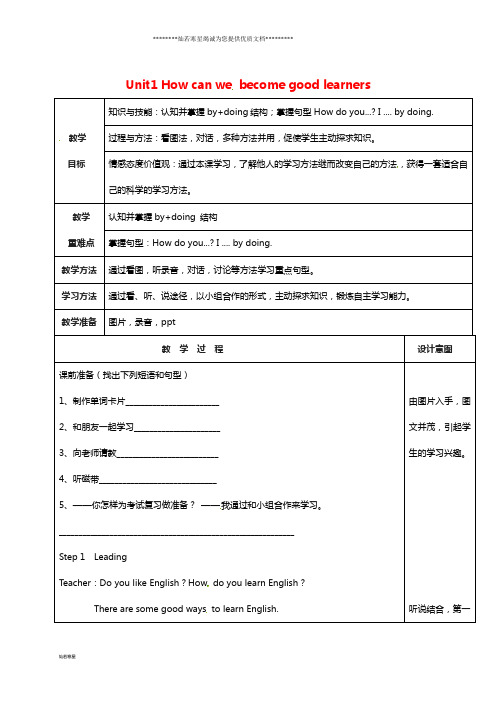
Unit1 How can we become good learners教学目标知识与技能:认知并掌握by+doing结构;掌握句型How do you...? I .... by doing.过程与方法:看图法,对话,多种方法并用,促使学生主动探求知识。
情感态度价值观:通过本课学习,了解他人的学习方法继而改变自己的方法,获得一套适合自己的科学的学习方法。
教学重难点认知并掌握by+doing 结构掌握句型:How do you...? I .... by doing.教学方法通过看图,听录音,对话,讨论等方法学习重点句型。
学习方法通过看、听、说途径,以小组合作的形式,主动探求知识,锻炼自主学习能力。
教学准备图片,录音,ppt教学过程设计意图课前准备(找出下列短语和句型)1、制作单词卡片________________________2、和朋友一起学习______________________3、向老师请教__________________________4、听磁带______________________________5、——你怎样为考试复习做准备?——我通过和小组合作来学习。
____________________________________________________________Step 1 LeadingTeacher:Do you like English?How do you learn English?There are some good ways to learn English. 由图片入手,图文并茂,引起学生的学习兴趣。
听说结合,第一Step 2 New lesson1.学生领读1a中的短语,教师纠正错误读音,学生识记短语后再添加其他的学习英语的方法并且熟悉by doing s th.的用法。
2.认真听录音,看看这些学生的学习方法,紧挨着名字写下图中的字母。
人教新目标九年级全册英语教案Unit 7 Teenagers should be allowed to choose their own clothes
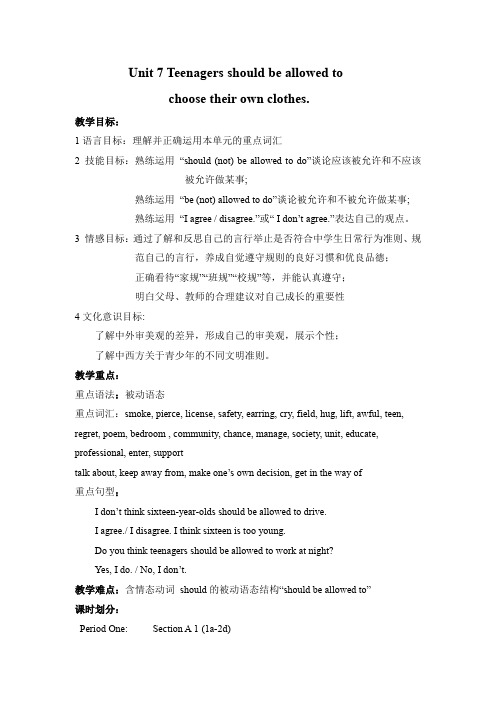
Unit 7 Teenagers should be allowed tochoose their own clothes.教学目标:1语言目标:理解并正确运用本单元的重点词汇2 技能目标:熟练运用“should (not) be allowed to do”谈论应该被允许和不应该被允许做某事;熟练运用“be (not) allowed to do”谈论被允许和不被允许做某事;熟练运用“I agree / disagree.”或“ I don’t agree.”表达自己的观点。
3 情感目标:通过了解和反思自己的言行举止是否符合中学生日常行为准则、规范自己的言行,养成自觉遵守规则的良好习惯和优良品德;正确看待“家规”“班规”“校规”等,并能认真遵守;明白父母、教师的合理建议对自己成长的重要性4文化意识目标:了解中外审美观的差异,形成自己的审美观,展示个性;了解中西方关于青少年的不同文明准则。
教学重点:重点语法:被动语态重点词汇:smoke, pierce, license, safety, earring, cry, field, hug, lift, awful, teen, regret, poem, bedroom , community, chance, manage, society, unit, educate, professional, enter, supporttalk about, keep away from, make one’s o wn decision, get in the way of重点句型:I don’t think sixteen-year-olds should be allowed to drive.I agree./ I disagree. I think sixteen is too young.Do you think teenagers should be allowed to work at night?Yes, I do. / No, I don’t.教学难点:含情态动词should的被动语态结构“should be allowed to”课时划分:Period One: Section A 1 (1a-2d)Period Two: Section A 2 (3a-3c)Period Three: Section A 3 (Grammar Focus-4c)Period Four: Section B 1 (1a-2e)Period Five: Section B 2 (3a-Self Check)Section A 1 (1a-2d)I. PresentationAsk students: Do your parents allow you to watch TV? Yes, they do.Present the sentence: You are allowed to watch TV.Teach “allow sb to do sth ““be (not) allowed to do sth”“should (not)be allowed to do sth”Present more sentence.Do your parents allow you to exercise?Yes, they do.You are allowed to exercise.Do your parents allow you to smoke?No, they don’t.You are not allowed to smoke.Do your parents allow you to drive?No, they don’t.You are not allowed to drive.Do your parents allow you to choose your own clothes?No, they don’t.You should be allowed to choose your own clothes.Do your parents allow you to get your ear pierced?No, they don’t.You should not be allowed to get your ear pierced.II. Warming upObey the school rules!As a teenager, you have a lot of rules at school. Can you write down some of them?Students should be allowed to speak English loudly.Students shouldn’t be allowed to sleep in class.Students shouldn’t be allowed to make noises.Students shouldn’t be allowed to throw the rubbish in the classroom. Students s houldn’t be allowed to get to class late.Explain:allow sb to do sth允许某人做某事be allowed to do sth被允许做某事should be allowed to do sth应该被允许做某事1a. Read the statements below. Circle A for agree or D for disagree.1. Teenagers should not be allowed to smoke. A D2. Sixteen-year-olds should be allowed to drive. A D3. Students should not be allowed to have part-time jobs. A D4. Sixteen-year-olds should be allowed to get their ears pierced. A D5. Teenagers should be allowed to choose their own clothes. A D III. Listening1b Listen and circle T for true or F for false.1. Anna can go to the shopping center by bus. T F2. Anna wants to get her ears pierced. T F3. Anna wants to choose her own clothes. T F IV. Practice1c Look at the statements in la and make conversations.A: I don't think sixteen-year-olds should be allowed to drive.B: I agree. They aren't serious enough.V. Key phrases1. be allowed to do 被允许去做2. the shopping center 购物中心3. driver’s license 驾驶执照4. sixteen-year-olds 16岁的孩子5. be worried about your safety 担心你们的安全6. part-time jobs 兼职工作7. get their ears pierced 穿他们的耳朵8. their own clothes 他们自己的衣服9. serious enough 足够严肃VI. Listening2a What do es Molly think of Kathy’s statements? Listen and circle A for Agree,D for Disagree or DK for Doesn’t Know.2b Listen again. What are Kathy’s and Molly’s reason s? Number their reasons in the correct order._____ It looks cool._____ Young people need to sleep._____ He needs to spend time with friends._____ He needs time to do homework._____ It doesn't look clean.VII. Practice1. 2c Make a list of things teenagers should and should not be allowed to do. Discussyour list with your partner.A: Do you think teenagers should...?B: Yes, I .../No, I...2. 2d Read the conversation and answer the questions.1) Where do they go for school trip?2) Does Mr. Smith allow students to take photos?3) How to take photos?3. Role-play the conversation.VIII. Summary1. Language pointsallow的用法1) Teenagers should be allowed to choose their own clothes.2) Teenagers should not be allowed to smoke.3) It is not allowed in the museum.4) Do you think we may be allowed to take photos if we don't use a flash?以上四句都含有重要的句型be allowed to do sth.,其中第三句是此句型的一般现在时,一二四句是情态动词与此句型的混合使用。
(共14套)最新人教新目标版 九年级英语(全册)教学案汇总(含全册内容)(打包下载)
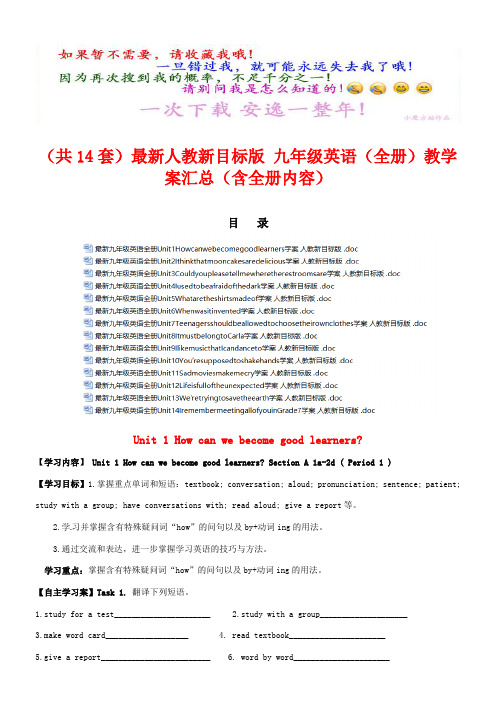
(共14套)最新人教新目标版九年级英语(全册)教学案汇总(含全册内容)目录Unit 1 How can we become good learners?【学习内容】Unit 1 How can we become good learners? Section A 1a-2d ( Period 1 )【学习目标】1.掌握重点单词和短语:textbook; conversation; aloud; pronunciation; sentence; patient; study with a group; have conversations with; read aloud; give a report等。
2.学习并掌握含有特殊疑问词“how”的问句以及by+动词ing的用法。
3.通过交流和表达,进一步掌握学习英语的技巧与方法。
学习重点:掌握含有特殊疑问词“how”的问句以及by+动词ing的用法。
【自主学习案】Task 1. 翻译下列短语。
1.study for a test______________________2.study with a group____________________3.make word card___________________4. read textbook______________________5.give a report_________________________6. word by word______________________7.大声朗读_________________________ 8.对话____________________________9.练习发音__________________________Task 2. I study for a test by____________________________________________I learn English by________________________________________________【合作学习案】e g. A: How do you study for s test? / learn English?B:I study for a test / learn English by...①—How do you study for a test? —I study by working with a group.②We usually go to school by bike.③English is spoken by many people.by的意思是“通过……的方式”时,后接;当表示“乘坐”时, 后跟;它还可以表示 , 用于被动语态,引导出动作的发出者。
